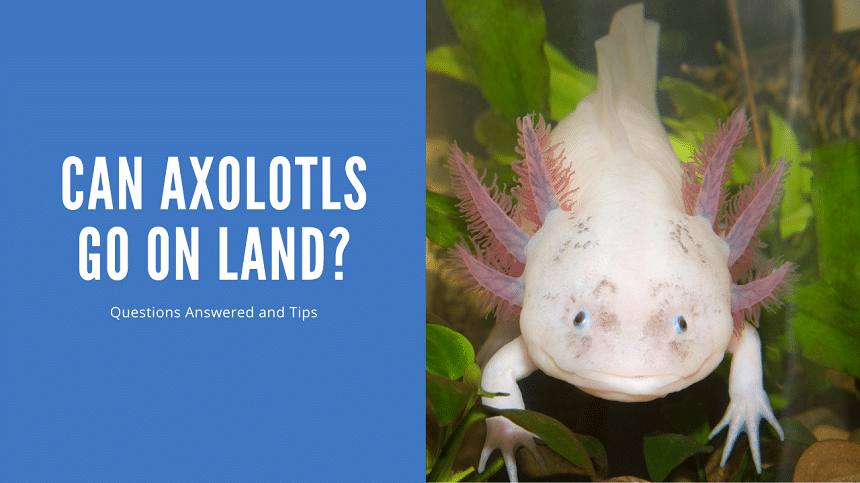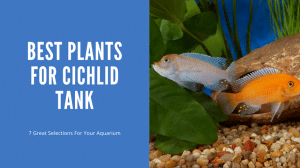Thank you for visiting! By the way… any links on this page that lead to products on Amazon and other stores/partners are affiliate links Aquarium Store Depot earns a commission if you make a purchase.
Many novice fish hobbyists scratch their heads in confusion because if axolotls are amphibians and ask, can axolotls go on land. When they get the answers, they may wonder — why can’t they live on land?
The query is quite baffling as it questions the amphibious nature of axolotls. However, in this article, I’m going to state some facts to clear your confusion.
Keep reading!
Can Axolotls Go On Land?
No! Axolotls are strictly aquatic animals that spend their entire lives in water. They can, however, spend a short time outside of water because they can breathe air, but won’t survive without water for long.
Did you know?
To check the adaptability of axolotls without water, scientists experimented.
In the experiment, scientists injected the axolotl with Iodine in the laboratory to undergo the process of metamorphosis1. Surprisingly, the experiment went well and the axolotl adapted well to the outside world. That axolotl resembled tiger salamander species.
Can They Breathe air?

Of course, axolotls can breathe air. Like many amphibians, axolotls use gills to breathe the air because of the absence of lungs. However, for axolotls, the gills play a crucial role. The external gills of axolotls help them exchange gases from their body and bring healthy gases, including oxygen. Thus, the exchange of gases in axolotls happen usually in water where the gills operate in three areas:
- On the left side of the head
- On the right side of the head
- On the top of the head
The gills work only a few minutes outside the water allowing axolotls to breathe air. Therefore, it’s not recommended to keep your smiley pets outside of water for an extended period of time.
How long can they be out of water?
Axolotls can survive out of water for around one hour, provided that the area is moist and damp.
Axolotls are pretty demanding creatures when it comes to their right environment. They require cool temperature, controlled water flow, dim lights, and a steady water level to function properly. Therefore, if their requirements are not meant, axolotls go into stress and might die eventually.
Why Can’t They?
The Mexican walking fish, like all other salamander species, start their life underwater as a tiny, translucent egg. Later, they develop into tadpoles, with gills and a flat, fin-like tail. This is a phase in the life of salamanders where they shed these features — develop lungs and eventually crawl onto land.
However, things are different for axolotls. They never grow out of their larval stage, even as adults.
The morphological characteristics of axolotls are designed to live underwater. Axolotls have reddish-purple gills because of the presence of blood cells that pull oxygen from the water instantly. When axolotls breathe, they just flap those gills. But sometimes, when there is not enough oxygen in the water, axolotls have a backup plan.
Axolotls use their lungs to gulp air from the surface in the absence of dissolved oxygen in the water. And this is what makes them special. Their lungs are an ideal example of cryptic metamorphosis, where they have matured to their next developmental phase internally, but not externally.
And so, these smiley amphibians cannot go on land and only thrive underwater.
Can They Breathe On Land?
The fact that axolotls have two respirators: Gills and Lungs, makes people believe that axolotls can live or breathe on land. However, this is not true.
Axolotls can breathe outside of water, that too, for a short period. It’s unnatural for an axolotl to breathe or live on land continuously. You can take your axolotl out of water in emergency situations only because they get easily stressed and have breathing problems.
How Do Their Gills Work?
Now that we know axolotls have gills, even in their adult life, let’s have a look at the working of axolotls’ gills.
Axolotls have external gills, but to breathe outside of water, they have lungs too.
The external gills of axolotls look like feathery branches on the back left and right side of the head. These feathery gills flap around and move in the current, allowing axolotls to breathe dissolved oxygen underwater. Your smiley pal can also contract and unfurl their gills manually.
There are small capillaries on the feathery gills that exchange oxygen and other gasses with the water. They absorb oxygen from the water, essential to axolotls’ health. The oxygen is later diffused into the bloodstream. The diffused blood is then carried out to the organs and other body parts of axolotls.
If you want to inspect your axolotl for any diseases or breathing issues, always notice their gills.
The healthy gills should flap at a steady and consistent pace. If they’re flapping too fast and inconsistently, it’s a sign that they are infected and inflamed.
An intriguing fact:
Unlike many fish, axolotls can simply stay at one spot, flapping their feathery gills and pushing oxygen into the capillaries. However, fish need to swim around to pimp oxygen through their gills.
Keep in mind that when an axolotl is comfy and healthy, those gills should flap at a slow and consistent pace, or something may be wrong. Fast and inconsistent gill flapping is a sign that the gills may be infected or that the axolotl is having trouble breathing in general.
Can They Walk?
We all know that axolotls have legs, which might make you believe that they can walk on land. But axolotls cannot walk on land.
However, in the cold season, they sometimes become semi-aquatic animals and adapt to the land environment.
Also, male axolotls, during the breeding season, fasten their tail to the body and use their legs to walk on the surface of the water. But they have never been seen walking on the land.
Can You Hold Them Out Of Water?
I never recommend holding your axolotl in or out of water for obvious reasons:
- Axolotls have sensitive bodies
- They have permeable skin
- The body of axolotls has a mucus coat to keep them hydrated and moist.
Therefore, handling your axolotl is very risky. If you must move your pet axolotl to clean the tank or move it to another tank, I recommend using a soft net to save the animal from potential damage.
What Happens When They are Carried Out of Water?
As we know, an axolotl can live on outside water for around an hour as long as it is moist and cool. But what happens when you keep it outside water for too long? Let me warn you: Things can get pretty ugly!
The body of axolotls is covered with a slime coat. Staying out of water for an extended period of time may dry the slime coat out. Also, axolotls need to breathe after using all the air in their lungs. And in this process, half of the axolotls may die, while the stronger ones survive.
The reason why slime coat is essential for the survival of axolotls is the same as the scales of fishes and spiky hard scales of crocodiles. This slimy coat shields the axolotls against predators and adds an extra protective layer to their highly sensitive skin.
Also, it protects the axolotls from any kind of infection, viruses, or bacteria around them.
Therefore, carrying an axolotl out of water is a bad idea, because there’s a reason why, in their natural habitat, axolotls thrive underwater at ALL TIMES.
Here are some of the consequences of keeping your axolotls on land for long periods.
Damage to Limbs and Organs
One of the major reasons you shouldn’t carry your axolotl out of the water is the threat to their limbs and other body organs on land.
Axolotls are amphibians that never undergo metamorphosis, unlike other salamanders. Therefore, the limbs of axolotls cannot support the weight on dry land like their salamander cousins.
However, they use their legs to walk in the water with the natural buoyancy created by water waves that carry much of the axolotls’ weight. On land, then water buoyancy is absent, and so the legs of axolotls cannot support the weight for an extended period.
If you force an axolotl to walk on land, it causes potential stress in the animal and legs can be damaged with a severe loss of mucus coating, eventually leading to the death of your adorable pet.
Also, the forceful walk on land and the pressure of the body against the weight of axolotl might crush internal organs that do no good to your smiley pet.
Dehydration, Breathing Troubles, and Other Diseases
As mentioned earlier, the skin of axolotls is covered with a thick slimy mucus to keep the animal moist. When you take your axolotl out of the water, the slimy coating can get severely dry and the skin won’t be able to absorb oxygen through a dry surface. The slimy coating also protects axolotls from potential dangers, including bacteria, parasites, and severe dehydration.
The loss of mucus coating poses a serious threat to your axolotl, including developing diseases, and infections caused by dangerous bacteria and viruses.
Also, a dehydrated axolotl is a sick axolotl. Keeping your axolotl out of water for too long leads to dehydration that exposes your animal to many diseases.
Dehydration can also cause organ damage due to extreme water evaporation without the slimy protective coating. When axolotls dry out, they can’t breathe with their gills properly. And on the lungs, the axolotls cannot function for too long.
Therefore, to prolong the life of your axolotl, keep them hydrated and underwater as much as you can.
If you keep an axolotl out of water for a long time, it can become very reclusive, resulting in low appetite, and fretful behavior. These are stress-related issues that may have an adverse reaction on the health of your axolotl, leading to the development of diseases and illness.
FAQS
Here’s a video with some great facts and and some FAQS below.
Can they stay out of the water like other salamanders?
No, axolotls cannot stay out of the water, like other salamanders. Axolotls are amphibians that do not undergo metamorphosis and stay underwater their entire lives. Like other salamanders, they possess both lungs and gills. However, they use their gills to breathe underwater.
Do they breathe underwater?
Axolotls are aquatic animals that do not undergo metamorphosis into land-adapted amphibians. And though, they develop functional lungs, axolotls use their gills to breathe underwater.
How long can they stay on land?
Axolotls survive for about an hour in optimal conditions on land, i.e., they should be moist, and remain in a cool atmosphere with little to no sunlight.
Can they drown?
An axolotl can drown only if it’s dying or weak. Sometimes, even when you provide an optimal tank environment to your axolotls, things might get out of hand. Therefore, I always emphasize installing chillers, filters, and airstone to the axolotl tank to avoid these problems.
How Long Can An They Live Underwater?
Axolotls are aquatic animals with a lifespan of around 15 years if their requirements and basic needs are met.
Conclusion
Axolotls are aquatic animals that are designed to live underwater entirely. An axolotl, if kept outside of water, for too long can develop many diseases and illnesses. Therefore, they cannot go on land, and it’s not advised to keep them out of water for too long.
- About the Author
- Latest Posts
I’m thrilled that you found Aquarium Store Depot! Here you’ll find information on fish, aquariums, and all things aquatics related. I’m a hobbyist (being doing this since I was 11) and here to help other hobbyists thrive with their aquariums! I adhere to a high quality Editorial Process and Review products with real life field usage and practical analysis.






This really helps me. I’m planning on having an Axolotl and I needed to know this.